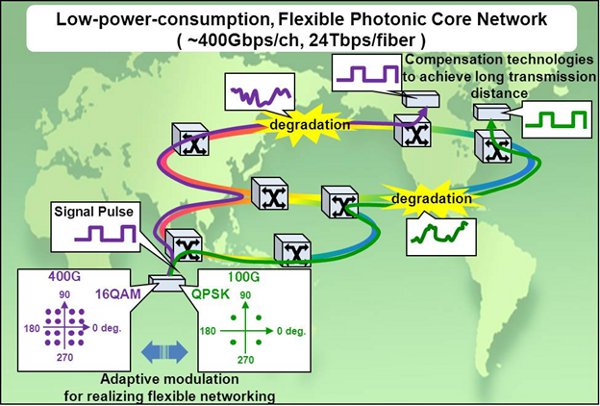Archived content
NOTE: this is an archived page and the content is likely to be out of date.
Fujitsu, NTT and NEC Launch Joint R&D for World's Top-Level, 400Gbps-class Optical Transmissions Technology
To deliver optical networks that are both energy efficient and flexible
Fujitsu Limited,Nippon Telegraph and Telephone Corporation,NEC Corporation
-
[1] Digital coherent optical transmission technology
A next-generation optical transmission method that combines coherent reception and digital signal processing. In addition to streamlining frequency usage through modulation methods such as polarization wave multiplexing and phase modulation, the technology enables significant improvements in reception sensitivity.
-
[2] DSP-LSI
Digital Signal Processing LSI. A signal processing method for converting analog data to digital data. http://www.ntt-electronics.com/new/information/2012_02_29.html
-
[3] Dual-polarization quadrature phase shift keying
A technique in which information is conveyed through an optical wave's oscillation timing (phase).
-
[4] Quadrature amplitude modulation
A technique in which information is conveyed through both an optical wave's amplitude and phase.
-
[5] Nonlinear optical effects
A phenomenon in which the optical fiber's refractive index changes in response to the light's intensity.
-
[6] Chromatic dispersion
A phenomenon in which different wavelengths are transmitted at different speeds within an optical fiber.
-
[7] Polarization mode dispersion
A phenomenon that causes differences in transmission delay times within optical fibers due to polarization (direction of vibrations in the electrical field).
-
[8] Adaptive modulation/demodulation
Technology that enables the efficient operation of optical network resources through improved line quality by switching to the optimal modulation/demodulation method depending on the characteristics of the optical network.
About Fujitsu
Fujitsu is the leading Japanese information and communication technology (ICT) company offering a full range of technology products, solutions and services. Over 170,000 Fujitsu people support customers in more than 100 countries. We use our experience and the power of ICT to shape the future of society with our customers. Fujitsu Limited (TSE:6702) reported consolidated revenues of 4.5 trillion yen (US$54 billion) for the fiscal year ended March 31, 2012. For more information, please see http://www.fujitsu.com.
About NTT
NTT Group is the largest provider of wireline and wireless voice, data, leased circuit, telecommunications equipment, and system integration services in Japan, and operates one of the largest telephone networks in the world. Its predominant business is to provide nation-wide telecommunications services.
NTT Group's business domain consists of five primary lines of business:
regional communications business, long distance and international communications business, mobile communications business, data communications business, and other business.
NTT Group reported consolidated revenues of 10.5 trillion yen (US$130billion) for the fiscal year ended March 31, 2012. Over 220,000 NTT Group people support customers in more than 100 countries. For more information, please see http://www.ntt.co.jp/ir.index_e.html
About NEC Corporation
NEC Corporation is a leader in the integration of IT and network technologies that benefit businesses and people around the world. By providing a combination of products and solutions that cross utilize the company's experience and global resources, NEC's advanced technologies meet the complex and ever-changing needs of its customers. NEC brings more than 100 years of expertise in technological innovation to empower people, businesses and society. For more information, visit NEC at http://www.nec.com.
Press Contacts
Nippon Telegraph and Telephone CorporationScience and Core Technology Laboratory Group, Public Relations
![]() E-mail: a-info@lab.ntt.co.jp
E-mail: a-info@lab.ntt.co.jp
Company:NTT
Press Contacts
Joseph JasperNEC Corporation
![]() Phone: +81-3-3798-6511
Phone: +81-3-3798-6511
![]() E-mail: j-jasper@ax.jp.nec.com
E-mail: j-jasper@ax.jp.nec.com
Company:NEC
All company or product names mentioned herein are trademarks or registered trademarks of their respective owners. Information provided in this press release is accurate at time of publication and is subject to change without advance notice.
Date: 11 December, 2012
City: Tokyo, Japan
Company:
Fujitsu Limited,
Nippon Telegraph and Telephone Corporation,
NEC Corporation,
,
,
,
,
,
,
,
